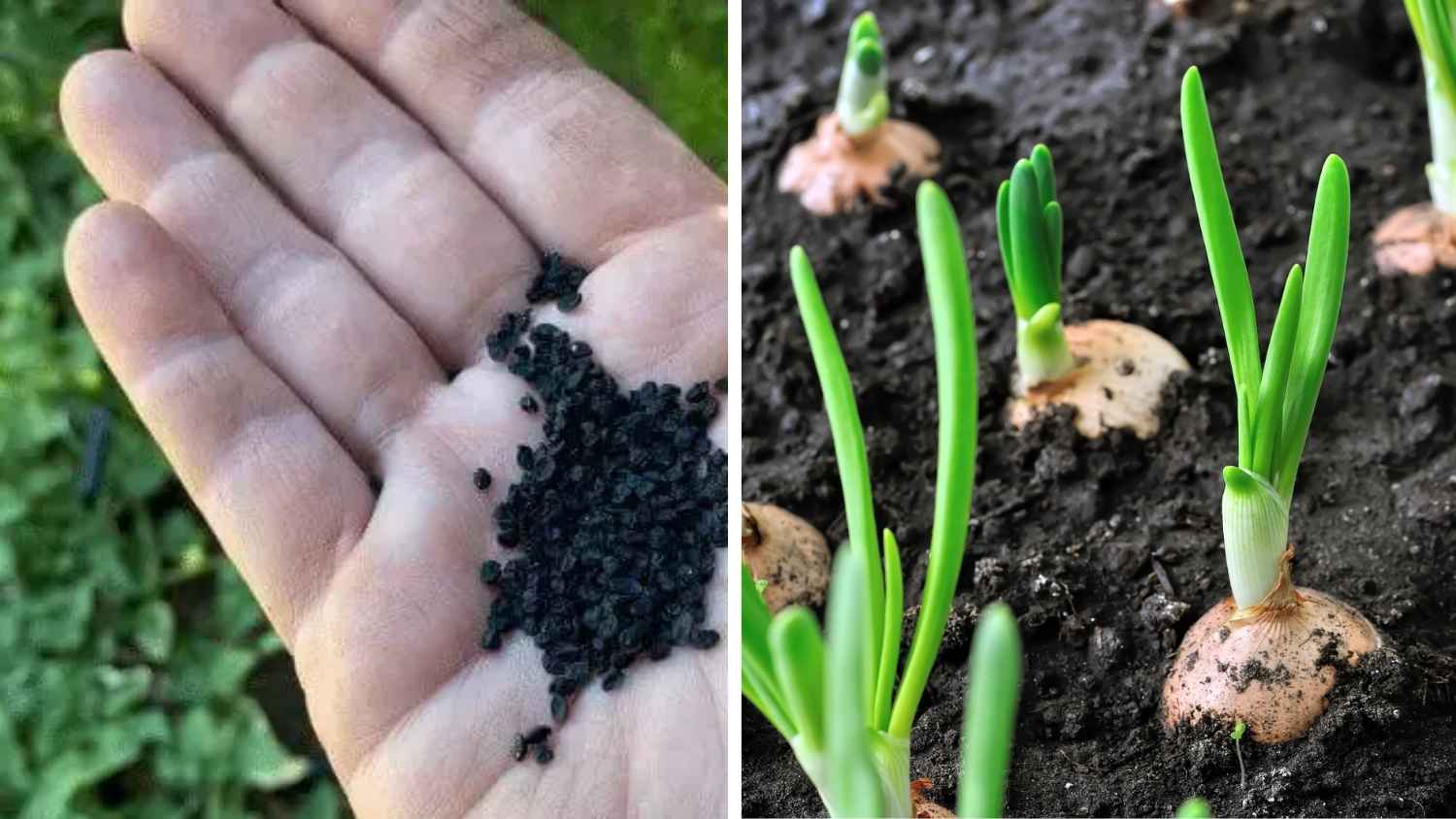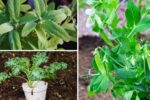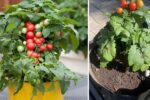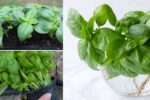Growing onions from seeds in containers is an ideal solution for anyone with limited space, such as urban dwellers or balcony gardeners. Onions are a staple ingredient in many cuisines and growing them at home can save you money and provide fresh produce year-round. Even if you have a small balcony or patio, you can successfully grow onions in containers with the right techniques. This step-by-step guide will help you grow healthy, flavorful onions in your small balcony garden.
Why Grow Onions in Containers?
Growing onions in containers offers several advantages for those with limited gardening space:
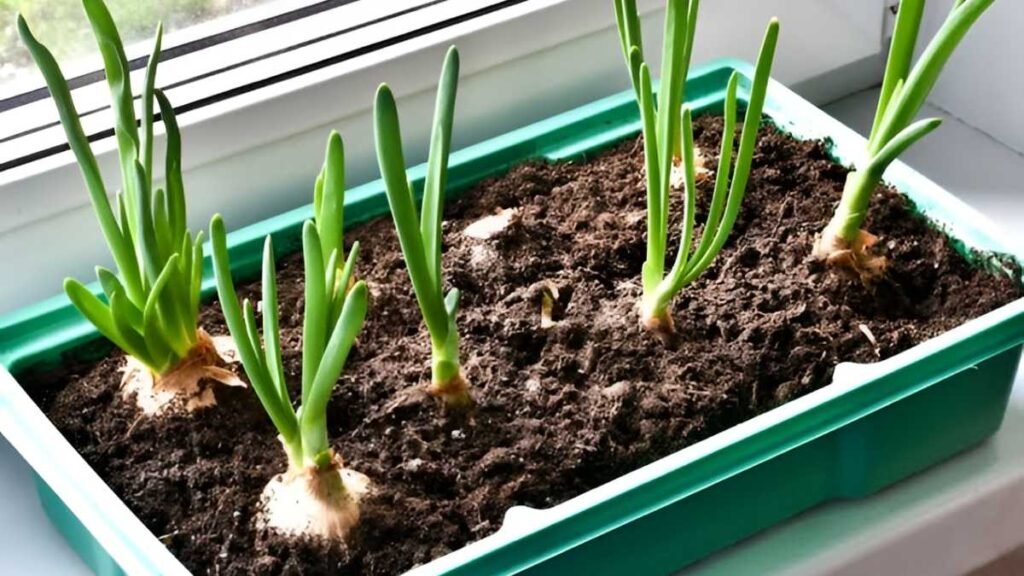
- Space Efficiency: Onions can thrive in small pots, making them perfect for balconies or patios.
- Ease of Mobility: You can move containers to ensure the plants get the right amount of sunlight or protect them from harsh weather.
- Pest Management: Container gardening helps you keep pests under control more easily than traditional garden beds.
- Soil Control: You can customize the soil to meet the needs of the onions, providing the right drainage and nutrients.
- Extend Growing Season: In cooler climates, pots can be moved indoors or into sheltered spots, extending the growing season.
Despite the advantages, container-grown onions require attention to detail in terms of watering, fertilizing, and sunlight to ensure a healthy harvest.
Choosing the Right Onion Varieties for Containers
When growing onions from seeds in containers, it’s essential to pick the right variety. Not all onions are suited for container growth, so choosing the right type is crucial for success.
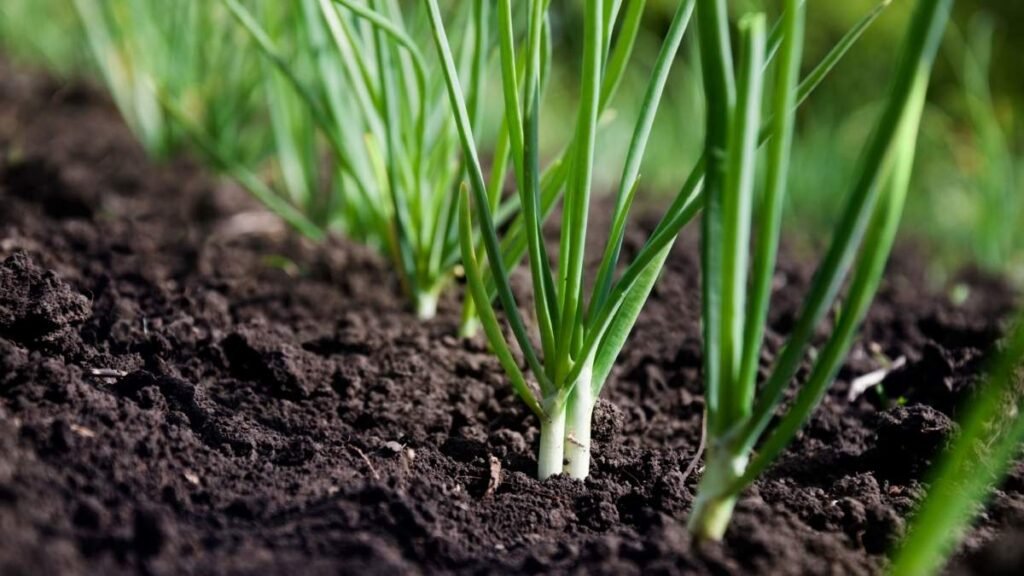
Best Onion Varieties for Containers
- Short-Day Onions: These onions need less light to trigger bulb formation, making them ideal for areas with mild winters. They grow best in southern regions.
- Examples: ‘Texas Super Sweet’, ‘Yellow Granex’
- Long-Day Onions: These varieties need longer daylight hours to produce bulbs, making them perfect for northern regions with longer summers.
- Examples: ‘Walla Walla’, ‘Sweet Spanish’
- Intermediate-Day Onions: These are a great choice for regions with moderate day length.
- Examples: ‘Candy’, ‘Stuttgarter’
For smaller containers, look for varieties labeled “compact,” “mini,” or “container-friendly,” as they are specifically bred to grow well in limited space.
Choosing the Right Containers for Onions
Selecting the right container is just as important as choosing the right variety. Onions need enough space for their roots to expand and grow but don’t require excessively large containers.
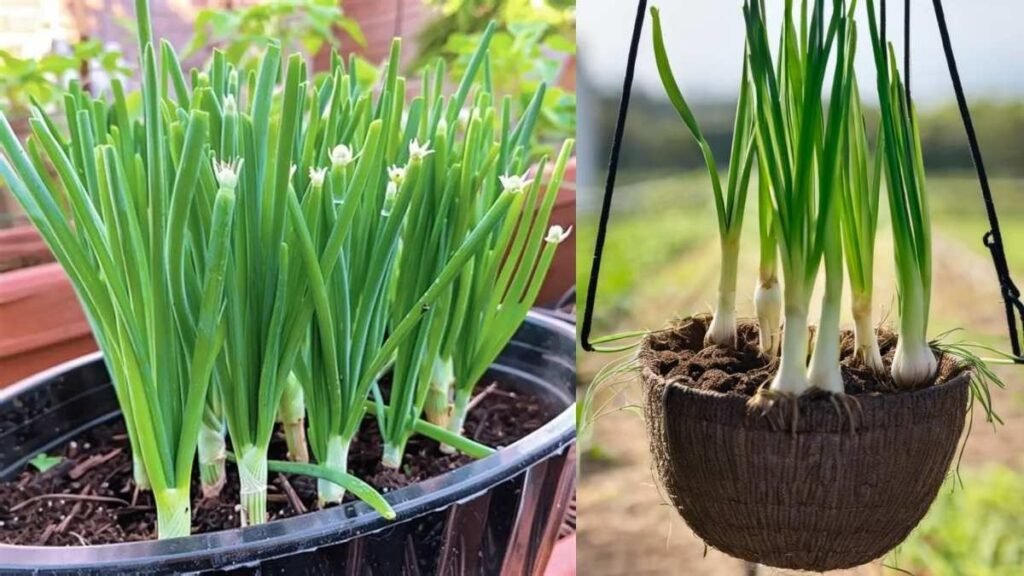
Ideal Container Features
- Size: Onions need at least 8–10 inches of depth for their roots to grow properly. Choose containers that are 5–7 gallons in size for a good yield.
- Material:
- Plastic pots: Lightweight and retain moisture well.
- Clay pots: Porous and allow good airflow but dry out faster.
- Fabric pots: Great for air pruning, which promotes healthier roots.
- Drainage: Ensure the container has good drainage to prevent waterlogging, which can lead to root rot.
Tip: Always place a saucer underneath the container to catch excess water, but make sure the pot is not sitting in standing water.
Preparing the Soil Mix for Onions
Onions prefer loose, well-draining soil that is rich in nutrients. A good soil mix helps prevent waterlogging while still retaining moisture.
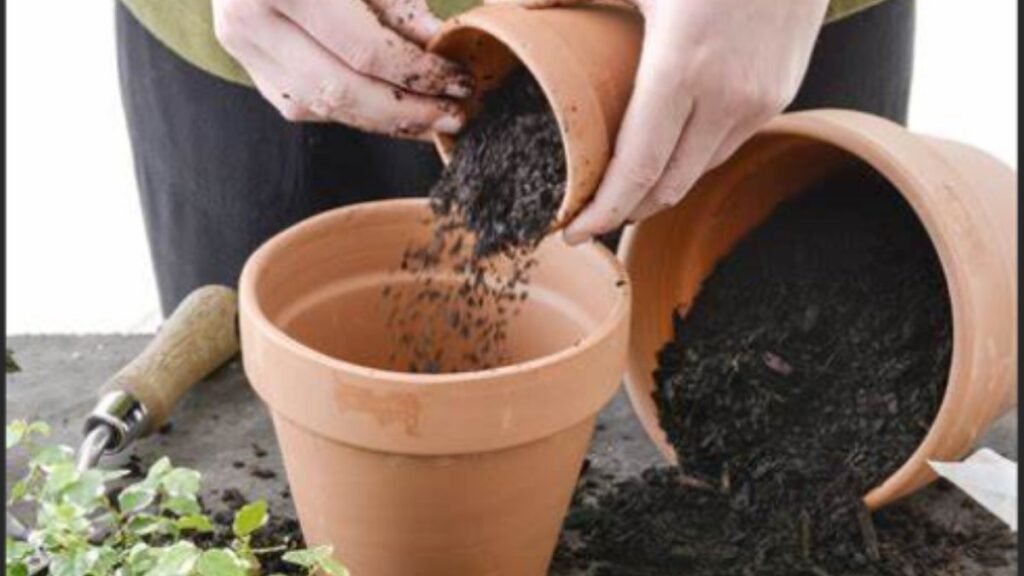
Ideal Soil Mix for Onions
- 50% high-quality potting soil
- 25% compost (adds nutrients and improves soil structure)
- 25% perlite or coarse sand (for good drainage)
Onions also prefer slightly acidic soil with a pH between 6.0 and 6.8. You can test your soil’s pH and amend it accordingly with lime if necessary.
Tip: Avoid using garden soil in containers, as it can become compacted and limit root growth. Stick to a well-draining potting mix instead.
Planting Onion Seeds
Onion seeds should be planted carefully to ensure they germinate and grow strong. Onions are a slow-growing crop, so starting them from seeds requires patience and attention.
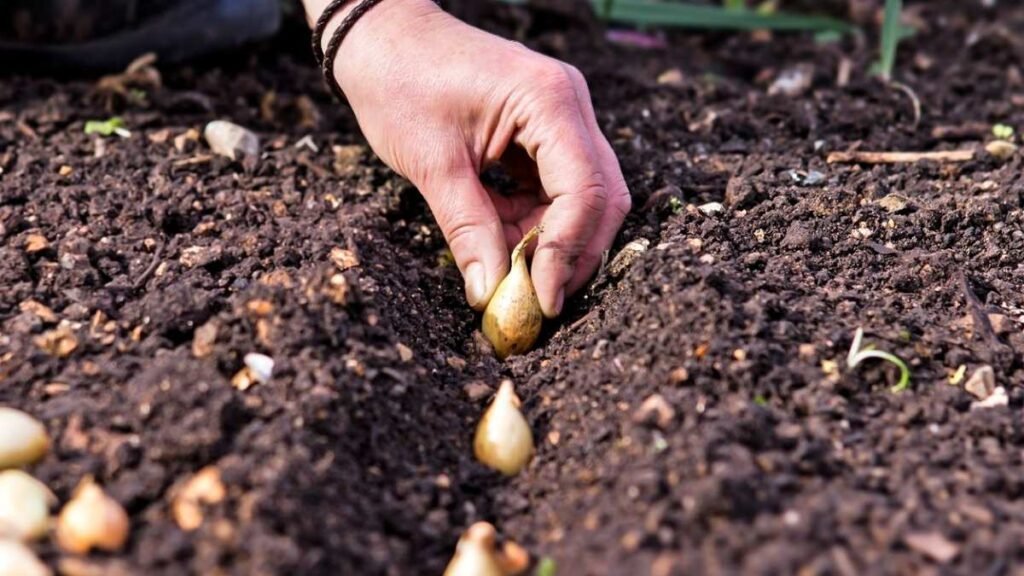
Step-by-Step Planting Process
- Fill the Container: Fill your container with the prepared soil mix, leaving about 2–3 inches from the top.
- Sow the Seeds: Scatter the onion seeds over the surface of the soil. Lightly press the seeds into the soil with your hand, but do not bury them too deep. Cover them with a thin layer of soil.
- Water Lightly: After planting, water the container gently to moisten the soil. Be careful not to wash away the seeds.
- Spacing: Ensure the seeds are spaced around 1 inch apart. Once the seedlings start growing, you may need to thin them out to give the remaining plants enough room to grow.
Tip: Onions can also be grown from sets (small bulbs), but growing from seed is more cost-effective and rewarding.
Watering Onions in Containers
Onions require consistent moisture, but they do not like to sit in wet soil. Overwatering can lead to root rot and other fungal issues.
Watering Guidelines for Onions
- Water deeply once or twice a day in hot weather.
- Make sure the soil stays moist but not soggy. The top of the soil should feel dry before you water again.
- Add mulch (like straw or shredded leaves) around the onions to help retain moisture and maintain soil temperature.
Tip: Water the soil directly rather than spraying the leaves to avoid promoting fungal growth.
Fertilizing Onions for Healthy Growth
Onions are heavy feeders, meaning they require regular feeding to thrive and produce large bulbs. Fertilizing your onions will ensure they have enough nutrients to grow strong and healthy.
Fertilization Schedule
- At Planting: Mix in some slow-release fertilizer or organic compost to give the onions a nutrient boost as they start growing.
- During Growth: Once the seedlings are established, feed them with a balanced liquid fertilizer every 2–3 weeks. You can also use fish emulsion or seaweed-based fertilizer.
- As Bulbs Form: Switch to a high-potassium fertilizer to encourage bulb development and prevent excessive leaf growth.
Tip: Avoid high-nitrogen fertilizers, as they promote leafy growth at the expense of bulb development.
Supporting and Pruning Onion Plants
Although onions do not require heavy pruning, keeping the plants healthy and ensuring they get enough sunlight is crucial.
Tips for Support and Maintenance
- Thin the Plants: Once the seedlings have grown a bit, thin them out to about 2–3 inches apart to allow enough space for each plant to develop properly.
- Remove Dead or Yellowing Leaves: Trim away any yellow or dead leaves to keep the plant healthy and prevent disease.
Harvesting Onions
Harvesting your onions is the most rewarding part of the growing process. Onions typically take about 90–120 days to reach maturity, depending on the variety.
Signs Your Onions Are Ready to Harvest
- The leaves will start to yellow and fall over.
- The bulbs will feel firm when gently squeezed.
- The onion tops will flop over.
Harvesting Process
- Gently pull the onions out of the soil by their tops, or use a garden fork to loosen them.
- Let the harvested onions dry in a shaded, well-ventilated area for about 7–10 days.
- Once dry, trim the roots and store the onions in a cool, dry place.
Tip: For the best flavor, harvest your onions in the morning before the sun heats up the bulbs.
Conclusion
Growing onions from seeds in containers on your small balcony is not only practical but also incredibly rewarding. With careful attention to the right variety, soil, watering, and care, you can enjoy fresh, homegrown onions throughout the year. By following these steps, you’ll be able to grow healthy, delicious onions even in the smallest of spaces.
Happy gardening, and enjoy the flavors of your own homegrown onions!

